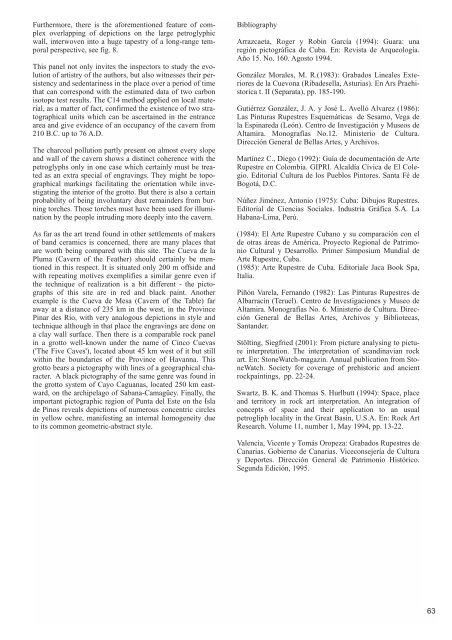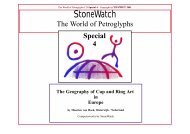Monts des Ksour" im Süd-Oranais / Nord-Algerien - StoneWatch
Monts des Ksour" im Süd-Oranais / Nord-Algerien - StoneWatch
Monts des Ksour" im Süd-Oranais / Nord-Algerien - StoneWatch
Sie wollen auch ein ePaper? Erhöhen Sie die Reichweite Ihrer Titel.
YUMPU macht aus Druck-PDFs automatisch weboptimierte ePaper, die Google liebt.
Furthermore, there is the aforementioned feature of complex<br />
overlapping of depictions on the large petroglyphic<br />
wall, interwoven into a huge tapestry of a long-range temporal<br />
perspective, see fig. 8.<br />
This panel not only invites the inspectors to study the evolution<br />
of artistry of the authors, but also witnesses their persistency<br />
and sedentariness in the place over a period of t<strong>im</strong>e<br />
that can correspond with the est<strong>im</strong>ated data of two carbon<br />
isotope test results. The C14 method applied on local material,<br />
as a matter of fact, confirmed the existence of two stratographical<br />
units which can be ascertained in the entrance<br />
area and give evidence of an occupancy of the cavern from<br />
210 B.C. up to 76 A.D.<br />
The charcoal pollution partly present on almost every slope<br />
and wall of the cavern shows a distinct coherence with the<br />
petroglyphs only in one case which certainly must be treated<br />
as an extra special of engravings. They might be topographical<br />
markings facilitating the orientation while investigating<br />
the interior of the grotto. But there is also a certain<br />
probability of being involuntary dust remainders from burning<br />
torches. Those torches must have been used for illumination<br />
by the people intruding more deeply into the cavern.<br />
As far as the art trend found in other settlements of makers<br />
of band ceramics is concerned, there are many places that<br />
are worth being compared with this site. The Cueva de la<br />
Pluma (Cavern of the Feather) should certainly be mentioned<br />
in this respect. It is situated only 200 m offside and<br />
with repeating motives exemplifies a s<strong>im</strong>ilar genre even if<br />
the technique of realization is a bit different - the pictographs<br />
of this site are in red and black paint. Another<br />
example is the Cueva de Mesa (Cavern of the Table) far<br />
away at a distance of 235 km in the west, in the Province<br />
Pinar <strong>des</strong> Río, with very analogous depictions in style and<br />
technique although in that place the engravings are done on<br />
a clay wall surface. Then there is a comparable rock panel<br />
in a grotto well-known under the name of Cinco Cuevas<br />
('The Five Caves'), located about 45 km west of it but still<br />
within the boundaries of the Province of Havanna. This<br />
grotto bears a pictography with lines of a geographical character.<br />
A black pictography of the same genre was found in<br />
the grotto system of Cayo Caguanas, located 250 km eastward,<br />
on the archipelago of Sabana-Camagüey. Finally, the<br />
<strong>im</strong>portant pictographic region of Punta del Este on the Isla<br />
de Pinos reveals depictions of numerous concentric circles<br />
in yellow ochre, manifesting an internal homogeneity due<br />
to its common geometric-abstract style.<br />
Bibliography<br />
Arrazcaeta, Roger y Robin García (1994): Guara: una<br />
región pictográfica de Cuba. En: Revista de Arqueología.<br />
Año 15. No. 160. Agosto 1994.<br />
González Morales, M. R.(1983): Grabados Lineales Exteriores<br />
de la Cuevona (Riba<strong>des</strong>ella, Asturias). En Ars Praehistorica<br />
t. II (Separata), pp. 185-190.<br />
Gutiérrez González, J. A. y José L. Avelló Alvarez (1986):<br />
Las Pinturas Rupestres Esquemáticas de Sesamo, Vega de<br />
la Espinareda (León). Centro de Investigación y Museos de<br />
Altamira. Monografías No.12. Ministerio de Cultura.<br />
Dirección General de Bellas Artes, y Archivos.<br />
Martínez C., Diego (1992): Guía de documentación de Arte<br />
Rupestre en Colombia. GIPRI. Alcaldía Cívica de El Colegio.<br />
Editorial Cultura de los Pueblos Pintores. Santa Fé de<br />
Bogotá, D.C.<br />
Núñez J<strong>im</strong>énez, Antonio (1975): Cuba: Dibujos Rupestres.<br />
Editorial de Ciencias Sociales. Industria Gráfica S.A. La<br />
Habana-L<strong>im</strong>a, Perú.<br />
(1984): El Arte Rupestre Cubano y su comparación con el<br />
de otras áreas de América. Proyecto Regional de Patr<strong>im</strong>onio<br />
Cultural y Desarrollo. Pr<strong>im</strong>er S<strong>im</strong>posium Mundial de<br />
Arte Rupestre, Cuba.<br />
(1985): Arte Rupestre de Cuba. Editoriale Jaca Book Spa,<br />
Italia.<br />
Piñón Varela, Fernando (1982): Las Pinturas Rupestres de<br />
Albarracín (Teruel). Centro de Investigaciones y Museo de<br />
Altamira. Monografías No. 6. Ministerio de Cultura. Dirección<br />
General de Bellas Artes, Archivos y Bibliotecas,<br />
Santander.<br />
Stölting, Siegfried (2001): From picture analysing to picture<br />
interpretation. The interpretation of scandinavian rock<br />
art. En: <strong>StoneWatch</strong>-magazin. Annual publication from <strong>StoneWatch</strong>.<br />
Society for coverage of prehistoric and ancient<br />
rockpaintings, pp. 22-24.<br />
Swartz, B. K. and Thomas S. Hurlbutt (1994): Space, place<br />
and territory in rock art interpretation. An integration of<br />
concepts of space and their application to an usual<br />
petrogliph locality in the Great Basin, U.S.A. En: Rock Art<br />
Research. Volume 11, number 1, May 1994, pp. 13-22.<br />
Valencia, Vicente y Tomás Oropeza: Grabados Rupestres de<br />
Canarias. Gobierno de Canarias. Viceconsejería de Cultura<br />
y Deportes. Dirección General de Patr<strong>im</strong>onio Histórico.<br />
Segunda Edición, 1995.<br />
63
















